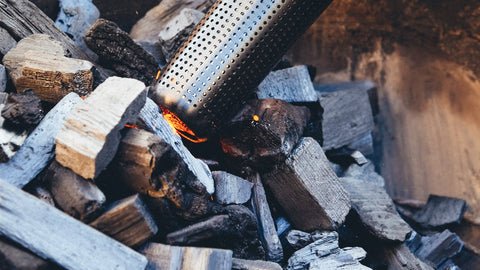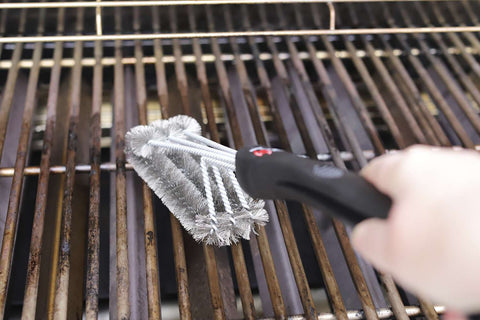Have you ever started getting ready to fire up the grill with your Looft Lighter only to wonder if your bag of leftover charcoal is still good?
That thought can pop into your mind if you don’t grill regularly and are not constantly refreshing your supply. Especially if you leave a bag of charcoal in a garage or garden shed for a long period.
That brings up the simple question; does charcoal go bad? The answer to this question is simple too – yes! Charcoal can go bad.
But there is also a much longer explanation, aka answer, to the question starting with this one. What’s your definition of “Bad” when it comes to charcoal? And what causes the all types of charcoal to go bad?
After all, there are different types of charcoal used for grilling and there are plenty of ways that charcoal can go bad starting with moisture! But first, we need to cover some basic questions.

How Long Does Charcoal Take to Burn Out?
First, what is charcoal? The definition is that charcoal is “a porous black solid, consisting of an amorphous form of carbon, obtained as a residue when wood, bone, or other organic matter is heated in the absence of air.” Simply put, that means when you burn some wood without air or with restricted airflow. The wood burns off the moisture and a big chunk of black charcoal is left – the carbon.
Charcoal has been used for treating wounds, gunpowder, as a medium for artists and charcoal drawings, as a writing tool, for absorption control, and even in makeup and toothpaste for a long time. Historians note that early Egyptians used powdered charcoal to treat wounds and eliminate bad odours. The Phoenicians used barrels with charred insides to store water which produced a better-tasting product.
The process of making charcoal has been around for over 30,000 years. And, cultures around the globe have been making various styles of compressed charcoal bricks for heating and cooking for centuries. But, we are going to skip past all of those different types and focus on the present.
So, how long does charcoal take to burn out? According to several sources… two days! At least where safety is concerned. I think it also depends on several factors. What type of charcoal – Lump or Briquette? Is the charcoal old or new, is the weather hot or cold, windy or not, and even what type of grill you are using? But, as mentioned above, charcoal can be safely removed from a grill and disposed of after 48 hours. By then it’s probably just a pile of powder and ash with some occasional larger pieces.
How Long Does Charcoal Stay Hot?
The question of how long does charcoal stay hot is tougher to answer than you might think. As a general rule, charcoal can stay hot enough to cook with for about 30-40 minutes on average. But as mentioned above, there are plenty of factors to consider ranging from type to the weather conditions.
Speaking from my experience, Lump charcoal seems to burn away quicker than briquette charcoal. I think the reason for this is that lump charcoal has no “average” size while briquettes are compressed to a uniform shape. So a lesser amount of air moves in between the pieces. That’s just my observation but the 30-40 minute estimate seems to be true.
Lump Charcoal is essentially a throwback to real wood charcoal that’s been made for centuries. It is usually a hardwood base that’s produced in batches commercially, bagged, and then sold. There’s not much difference between the charcoal you may find leftover from a smothered campfire to what’s in the bag. The differences would be in the quality of the wood used, no moisture, and more standard pieces.
Compressed charcoal briquettes use a combination of charcoal bits, pieces, and powder that are combined with wood chips and sawdust, fillers, and a binding agent. Depending on the manufacturer, the mixture is moistened, compressed into standard shapes – aka briquettes, and dried for the final product. The two other versions are almost the same with only slight differences.
You can extend the cooking time of both types of charcoal simply by adding additional pieces while cooking. This is part of the process, especially when working with charcoal and offset types of grilling and smoking.
How Long Does Charcoal Take to Heat Up?
The time it takes to heat up your charcoal for grilling also depends on how you light your charcoal. Of course, the other factors we’ve mentioned will come into play. But, it could take upwards of 30 minutes to get some charcoal ready for grilling.
Time will vary depending on how you choose to light your charcoal. There are plenty of methods including chimney starters, plug-in element starters, and many more. All of these methods rely on getting a small area of the charcoal heated enough where it starts to burn. Here’s where the added time comes in.
That small area heats up and expands slowly while eventually igniting additional pieces of charcoal until the whole pile is heating up. That can be a slow process. However, there is a way to speed the process using our electric firestarter Looft Lighter!
The Looft Lighter is the premiere grilling accessory that every grilling guru needs! This awesome charcoal lighter is a huge time saver when it comes to lighting charcoal or even campfires. The Looft lighters come in two models. One is a plug-in version and the second is battery-operated.
Start by getting your charcoal ready in the grill, point your Looft Lighter, and press the button. The Looft Lighter uses a continuous super-heated flow of hot air to start the burning process. You will never have to worry about the residue of charcoal lighter fluid again or by continuing to light your charcoal will pieces of paper in a chimney lighter.
When a few sparks begin to fly you’ll notice that a small area has begun to burn. Now, slowly move the lighter backward and away while keeping it aimed at the same location. The hot air flow intensifies the burning area of charcoal and it quickly expands. You’ll have your charcoal ready for grilling in a matter of minutes.
And, the Looft Lighter can help when charcoal goes bad! Here’s some more information every griller needs.

Yes, Charcoal Can Go Bad
Charcoal can go bad and there are a few ways this can happen. Remember all of the products, history, and attributes of charcoal mentioned above? One of those was moisture. Charcoal absorbs moisture from the air so that’s the number one culprit when it comes to why charcoal can go bad.
If you are a person that fires up the grill regularly then this may not be an issue for you. Chances are bags of charcoal don’t sit around for a long time. I’ve been known to buy 3-4 bags of charcoal at a time, especially when it is on sale. But if you’re only grilling a few times during the warmer summer months, or less, then you may have noticed that it may take longer to get old charcoal started.
Moisture
This could be the result of the charcoal being stored improperly over a long period and it has absorbed too much moisture. This can happen if your bag of charcoal is left out in an open area such as a shed, back porch, patio, etc. Of course, always make sure your bag of charcoal is closed tightly to extend the life and quality of the lumps or briquettes.
Crumbling due to Movement
This can be a problem that happens from the production facility to the vendor, to your grilling area. The more a bag of charcoal is handled, the more the pieces can break apart and crumble. Or, eventually, turn into a large bag of charcoal bits and pieces and charcoal powder. This happens with all types of charcoal. I suggest a few things to avoid this.
First, when you pick up a bag of charcoal move it around a bit- even turn it upside down - to see if there is an abnormal amount of noise coming from what could be a whole bunch of chips and powder moving around in the bag. Secondly, used the sight test. If a bag looks broken, worn, or slightly damaged then simply avoid it and select a different bag.
Self Lighting - Exposure to Air
This is the reason I included self-lighting charcoal in this article even though I don’t use it. This type of charcoal has a chemical additive which is essentially lighter fluid. That one difference gives it a unique reason why it can go bad. And that reason is exposure to air!
The longer that self-lighting charcoal sits around after the bag is opened the more the accelerant can evaporate. This is not a problem if you grill often, and the bag is folded closed between grilling sessions. But if you buy a bag of self-lighting charcoal and grill but don’t grill again for several weeks or months, you may notice that the charcoal may not light as fast. This is especially true if you have an open bag that lasts from one season to another.
The Good News about Bad Charcoal and the Looft Lighter!
Here’s the good news about charcoal that goes bad. If it’s only a little moist – it can still be used! A Looft Lighter acts like a grill lighter and can still start charcoal lumps or briquettes that have been exposed to moisture. It may take a few extra minutes but it will start to ignite as the hot airflow from the Looft Lighter gets rid of any moisture. All you are doing is warming up the charcoal to a point where the moisture burns off and then it goes from there as normal. And it also acts as a great Christmas gift for grillers!
Also, smaller pieces of charcoal found at the bottom of every bag can be put to good use. If you need some extra grilling time but don’t want to use a whole bunch of added charcoal toss some smaller pieces on. Smaller pieces and broken chunks can also be used to quickly start your charcoal. Place those towards the bottom or area where you are going to point your Looft Lighter.
Use the bottom of a chimney-style starter as it will start quickly and fire up the whole batch of larger pieces. A Looft Lighter will also get these smaller pieces going quickly which will help the larger chunks ignite.
Time to Start Grilling!
So yes, charcoal can go bad. But, there is hope as mentioned above. I tend to mix in old charcoal with new if I think a batch may be moist or wet. Mostly, my secret for avoiding most of the reasons that charcoal can go bad is to store it in a plastic container. Once I open a bag it goes into a plastic container until the next time I fire up the grill. Then I grab my Looft Lighter and get things going!



